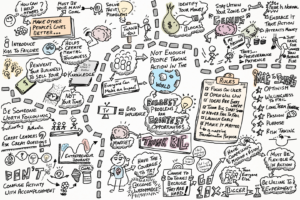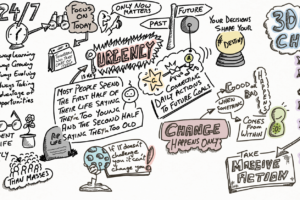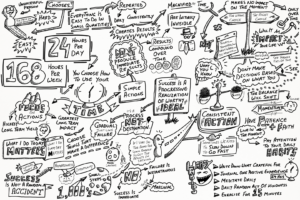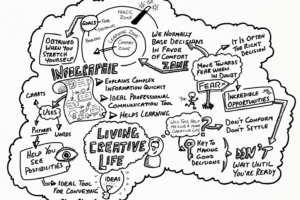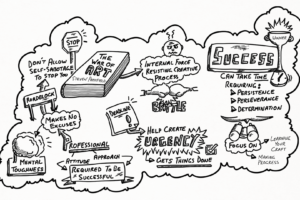Visual Note-Taking Course Outline

I hope you're ready to pack your bags on an incredible journey through the wonders of your own imagination. This journey will bring forth the creative spark to help you break boundaries in the way you think and present your ideas visually. Yes, we're about to jump into the world of visual note-taking.
Welcome Aspiring Visual Thinker!
I would like to congratulate you for taking the first step towards becoming a better visual thinker. This first step is probably the hardest step for most aspiring visual thinkers. It's, of course, a step that involves breaking boundaries and stepping outside our comfort zone to learn how put our thoughts down on paper in creative ways.
It's, of course, perfectly okay to feel a little apprehensive about this process. However, I do assume that you've gone through the introductory doodle course, and now probably feel a lot more comfortable with doodling.
This course builds upon the skills you developed in the beginner doodling course, but we are going to be taking things up a notch. Specifically, we are going to learn how to apply your doodling skills to creating visual notes.
You might for instance want to create visual notes to summarize a book or seminar. Maybe, you want to create visual notes in a meeting. Possibly, you may even want to create visual notes for a presentation, for selling, or even for coaching purposes. You could even be a teacher who might want to use visual notes to help keep your students interested and engaged. There are plenty of possibilities here. The only limit is your imagination.
What to Expect
Here's what to expect over the coming 11 lessons of the Visual Note-Taking Course.
First, you will receive an email from me once each day with a new course module. Each module provides you with a short introduction to each topic. Reading through this information will provide you with all the details you need to work through the daily doodling tasks I set. And these are simple tasks. I demonstrate things in my videos, and then ask you to have a go.
Over the course of several years we have had thousands of submissions from users who have already gone through what you're about to go through. Yes, some of these doodlers were apprehensive at first, but they still took the time to go through each lesson and made the most of it. 
Just like with the beginner doodle course, each of the lesson exercises won't take too much of your time. They are short exercises that might only take you a few minutes to complete. However, feel free to expand on what you are learning and put in a little more time into this process.
The more you commit yourself to this process, the greater value you will gain in the long-run.
The Course Outline
Below you will find our course outline and lesson plan. I hope that this outline will help provide you with more information about what you can expect over the coming 11 lessons.
Guidelines for Working Through this Course
As you work through this course you will no doubt be doing a lot of doodling, drawing, sketching, or whatever you might like to call it. Whether you do these sketches on a tablet or on paper doesn't matter. Whatever is most convenient for you. However, what I would suggest is that you keep all your doodles in one place for easy reference.
You could, for instance, have a designated notebook you use as you work through each lesson. Having a designated notebook will keep all your doodles in one place and will also allow you to track your progress.
I would also recommend working together with a partner. Of course, this partner doesn't necessarily need to be an adult. If you have kids then get them involved. Maybe they will help inspire you a little. 
If you're curious to learn more about the science behind the doodle and the value of visual thinking, then I would recommend you visit the following list of resources:
- What is a Doodle: This article describes what a doodle is, what is required to become a proficient doodler, and the distinction between a doodle and an IQ doodle.
- Hardwired to Think Visually: This article discusses how we are hardwired to think visually.
- Visual Thinking in Education: This article analyzes the state of the current education system and why visual thinking skills must be taught at schools.
- Doodle Studies: This article looks at three studies that showcase the value of doodling and how it can be used to improve learning and comprehension.
- Visual Thinking Through Time: This article walks you through examples of how visual thinking has been used and how it has evolved over time.
- Visual Thinking Magic: This website provides you with a few dozen articles that introduce you to the process of visual thinking and the value that it can bring to our lives.
Above all, have fun and enjoy this process. Remember that when it comes to doodling and visual note-taking that there is no right or wrongs. It's rather about finding your own personal visual note-taking style and then running with it. 
When it comes to becoming an effective visual thinker, it's not so much about your doodling skills but rather about getting your ideas across in the most effective way. You don't need to become the next Leonardo da Vinci. You just need to be "you" and make the most of this process.
It's All About Working on the Fundamentals...
When I first began my doodling journey I had absolutely no idea what I was doing. I couldn't doodle, and I definitely couldn't draw. However, I progressively took the time to master the basics of doodling.
Over many weeks and several months, I gained more confidence and expanded my skills. I eventually reached a point where I actually felt comfortable taking visual notes. By that stage I was avidly taking visual notes of the books I was reading, of podcasts I was listening to, and even of random stuff. Here are some examples.
I want to mention that when I started along this journey, I was probably where you are right now. I had no clue or idea what I was doing. However, by working through the fundamental principles of visual note-taking I eventually developed the confidence I needed to gain a level of comfort and proficiency in this area. And I'm sure you will too.
I'm of course no Picasso. And there are plenty of people who doodle and draw much better than I do. However, my goal wasn't to become an artist. All I wanted was to learn how to doodle so that I could express myself visually through visual note-taking. And that I suspect might also be your goal too.
Okay, with that said, let's get started along this exciting journey that will expand your imagination and enhance your creativity.





